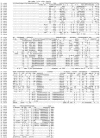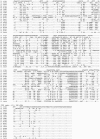Molecular identification of zygomycetes from culture and experimentally infected tissues
- PMID: 16455881
- PMCID: PMC1392659
- DOI: 10.1128/JCM.44.2.340-349.2006
Molecular identification of zygomycetes from culture and experimentally infected tissues
Abstract
Mucormycosis is an emerging infection associated with a high mortality rate. Identification of the causative agents remains difficult and time-consuming by standard mycological procedures. In this study, internal transcribed spacer (ITS) sequencing was validated as a reliable technique for identification of Zygomycetes to the species level. Furthermore, species identification directly from infected tissues was evaluated in experimentally infected mice. Fifty-four Zygomycetes strains belonging to 16 species, including the most common pathogenic species of Rhizopus spp., Absidia spp., Mucor spp., and Rhizomucor spp., were used to assess intra- and interspecies variability. Ribosomal DNA including the complete ITS1-5.8S-ITS2 region was amplified with fungal universal primers, sequenced, and compared. Overall, for a given species, sequence similarities between isolates were >98%. In contrast, ITS sequences were very different between species, allowing an accurate identification of Zygomycetes to the species level in most cases. Six species (Rhizopus oryzae, Rhizopus microsporus, Rhizomucor pusillus, Mucor circinelloides, and Mucor indicus) were also used to induce disseminated mucormycosis in mice and to demonstrate that DNA extraction, amplification of fungal DNA, sequencing, and molecular identification were possible directly from frozen tissues.
Figures



References
-
- Abe, A., T. Sone, I. N. Sujaya, K. Saito, Y. Oda, K. Asano, and F. Tomita. 2003. rDNA ITS sequence of Rhizopus oryzae: its application to classification and identification of lactic acid producers. Biosci. Biotechnol. Biochem. 67:1725-1731. - PubMed
-
- Council of the European Communities. 1986. Council Directive 86/609/EEC of 24 November 1986 on the approximation of laws, regulations and administrative provisions of the Member States regarding the protection of animals used for experimental and other scientific purposes. Official Journal of the European Communities. L 358, 18/12/1986, p. 0001-0028. Council of the European Communities, Brussels, Belgium.
Publication types
MeSH terms
Substances
Associated data
- Actions
- Actions
- Actions
- Actions
- Actions
- Actions
- Actions
- Actions
- Actions
- Actions
- Actions
- Actions
- Actions
- Actions
- Actions
- Actions
- Actions
- Actions
- Actions
- Actions
- Actions
- Actions
- Actions
- Actions
- Actions
- Actions
- Actions
- Actions
- Actions
- Actions
- Actions
- Actions
- Actions
- Actions
- Actions
- Actions
- Actions
- Actions
- Actions
- Actions
- Actions
- Actions
- Actions
- Actions
- Actions
- Actions
- Actions
- Actions
- Actions
- Actions
- Actions
- Actions
- Actions
- Actions
LinkOut - more resources
Full Text Sources
Medical
Miscellaneous

